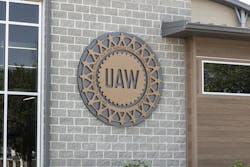UAW reports progress in labor negotiations; how is the strike affecting the plastics industry?
By Karen Hanna
The United Auto Workers (UAW) announced Friday it’s making progress in a strike auto industry stakeholders say already is reverberating beyond Detroit. Unlike prior weekly addresses, union President Shawn Fain announced no new expansion of the strike in a speech that aired live on social media.
In interviews with Plastics Machinery & Manufacturing (PMM), Laurie Harbour, who provides consulting services to a range of manufacturers, and Champion Plastics President Jeff Ignatowski said the strike could have ripple effects within the plastics industry.
Fain said the Big Three is starting to make concessions under the pressure of the strike, begun Sept. 15. He ticked off a series of concessions the Big Three have made in talks with the UAW.
Related: Coverage of the strike from Endeavor Business Media partners
“We were about to shut down GM's largest moneymaker in Arlington, Texas,” he said. “The company knew those members were ready to walk immediately, and just that threat has provided a transformative win. GM has now agreed in writing to place their electric (EV) battery manufacturing under our national master agreement. …
“We've been told the EV future must be a race to the bottom, and now we've called their bluff. What this will mean for our membership cannot be understated. The plan was to draw down engine and transmission plants and permanently replace them with low-wage battery jobs.”
Among other results he highlighted:
- Ford has upped its original wage-raise proposal from 9 percent to 23 percent, with GM and Stellantis offering raises just slightly less.
- Ford and Stellantis have agreed to reinstate cost-of-living allowances eliminated during the Great Recession, and the gap with GM on the issues is narrowing.
- The Big Three have proposed pay rates temporary workers in the $20-an-hour range.
- The Big Three have proposed cutting from eight years to three or four years the amount of time full-time workers must be on the job to hit the top tier of the pay scale.
However, sticking points remain, including union demands for the conversion of temporary workers to full-time workers, higher tool allowances, pension increases, and retirement security and health care for retirees. Among other issues, the union is fighting for job security and the right to strike over plant closures.
Fain, who reiterated his goal to win a record contract for the union, did not shed light on one oft-discussed demand — the 32-hour workweek.
“Here's the bottom line: We are winning. We are making progress. And we are headed in the right direction. And what has moved the needle is our willingness to take action, to be flexible, to be aggressive when we have to and to be strategic,” he said.
Consultant sees the effects
Days before Fain took to social media, Harbour said she’s already seen “pockets of pain.”
According to polling performed by the Motor & Equipment Manufacturers Association (MEMA), the percentage of suppliers affected by the strike will grow if it continues. In a survey of its members, MEMA found about 60 percent of suppliers expect to lay off workers by mid-October if the strike continues. Already, 30 percent of suppliers have laid off employees due to the strike, according to an Oct. 3 press release.
To help protect themselves, some companies have been game-planning various scenarios, said Harbour, president of Harbour Results, which lately has been taking calls from manufacturers concerned about how the strike will affect them.
But others are less proactive, Harbour said.
She advised that mold makers and molders approach the situation as they would any other possible disruption in the supply chain. They have to be flexible and agile, and they should know which vehicles they support with the parts they make.
She recommended manufacturers ask themselves, “What plans can I put in place to manage labor? How much inventory do I have on hand right now, and how much should I have on hand? What material purchases do I need to make now vs. later?”
“It's really about understanding your cash flow right now, and then understand what your orders are, what your levels of inventory are,” she said.
View from a shop floor
At Champion Plastics, a molder that derives about 85 percent of its business from the automotive industry, Jeff Ignatowski is taking a wait-and-see approach.
The UAW’s strategy of selecting particular Ford, GM and Stellantis plants to strike has mostly left the makers of popular large vehicles and their suppliers unscathed, Ignatowski said.
“I think what's been a benefit to us thus far, is most of the content we have, at least for General Motors, is on the large vehicles. ... I think the UAW knows that they're not going to go after the large trucks and SUVs. I equate that to almost a nuclear option,” he said.
But, if that were to happen, Ignatowski said, the outlook for Champion Plastics, which employs 25-30 people, would change dramatically.
"We’re just at this point keeping an eye on it,” Ignatowski said. “We've discussed potential layoffs or shortening our hours a little bit, if it was to affect us largely, but thus far, just kind of monitoring the situation. I think, if all of a sudden we get calls [that] our releases are being canceled, that will certainly change our position.”
In his address Friday, Fain wore an “Eat the rich” T-shirt. He suggested that the strike could still expand — if the union doesn’t continue to see progress.
“Today, I was ready to call on one of GM's biggest and most important plants to Stand Up. And it was that threat that brought GM to the table. The Big Three know we're not messing around, and they know if they want to avoid further strikes, then they'll have to pony up,” Fain said. “And I've heard members who want to bring down the hammer, strike all the truck plants, hit the Big Three where it hurts, and there is a time and place for that. Believe me, if the Big Three don’t continue to make progress, that time is going to be coming real soon.”
When it comes to how long other processors might be able to hang on, both Ignatowski and Harbour voiced concerns.
“I would guess other processors, though, would be greatly affected, if not permanently affected, if this goes on a lengthy period of time,” Ignatowski said.
In an earlier interview, Kelly Goodsel, president and CEO of parts supplier Viking Plastics, had a similar outlook: “There are going to be suppliers — small, medium, and large suppliers — that if this isn't resolved, in the next, call it four to six weeks, that by the end of the year, they're going to be out of business.”
Speaking before Fain’s latest announcement, Harbour called the week a pivotal one.
“We have a very vulnerable supply base as it is right now,” she said. “I believe there could be hundreds of companies that perish from this — if it extends longer and becomes more painful.”
Contact:
Harbour Results Inc., Southfield, Mich., 248-552-8400, https://harbourresults.com
About the Author
Karen Hanna
Senior Staff Reporter
Senior Staff Reporter Karen Hanna covers injection molding, molds and tooling, processors, workforce and other topics, and writes features including In Other Words and Problem Solved for Plastics Machinery & Manufacturing, Plastics Recycling and The Journal of Blow Molding. She has more than 15 years of experience in daily and magazine journalism.


